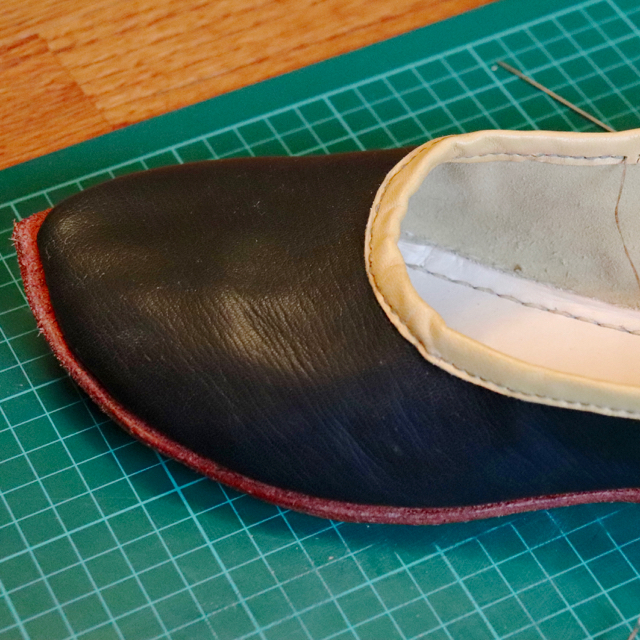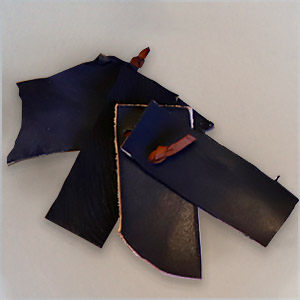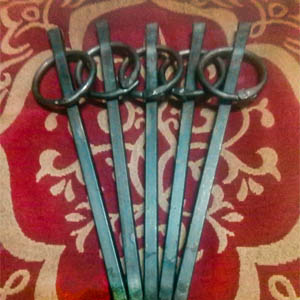Useful for vegetable-tanned leather only (also called bark tanned, oak tanned). The leather must contain tannin – this is a chemical found in most woody plants that a) is traditionally used to preserve leather and b) forms a black insoluble stain with iron.
Were leather goods, particularly shoes actually dyed black with iron in the early medieval period? If so, how commonly was this done? Hard to tell from archaeology – after long burial natural iron in the soil turns most leather black. You may notice black footwear in a lot of contemporary illuminations – but is this detail from life, or just inked in for ease?
My verdict: Likely to be common. Inexpensive, easy and such a good result. The same chemistry was definitely being used to make the incredibly long-lasting iron gall ink used in medieval manuscripts.
If you get a washed-out gray not proper dense black, your leather may not have sufficient tannin content. Maybe it’s actually preserved with alum, or more likely chrome (nasty, gasp!), or untanned (rawhide)?
You may be able to ‘top up’ the level in your leather with a long soaking in tannin extract – oak gall is suggested here because it has medieval pedigree but other tannin sources should work fine – e.g. tea leaves, tree bark. Experiment – don’t worry about too strong or too long, leather can only take up so much. Likewise, ‘found’ iron – rusty old nails etc. can substitute for filings (you can actually find filings online easily, its sold for kids to experiment with magnets). Later medieval ironworkers had a side-business providing scrap to cloth dyers, who kept vats topped up with vinegar and on the go for generations.
Ingredients
Iron solution: Soak 5 grams of iron filings in half a cup of white vinegar (I had wine vinegar – anyway, 125ml of 6% acetic acid). Gas is released (hydrogen), so cap loosely. Once fully dissolved (1 – 2 days) you should have a murky grey-brown solution, maybe with a scum or foam, and an intriguing fruity nose undercut by the tang of fresh blood…
Tannin extract (optional): Add 12.5 grams of oak gall powder* to 1 cup (250ml) of water. Cold or hot water will work, even boiling water which also stops mould growing (for a while). Stand at room temperature for at least couple of days, mixing occasionally. You should have a clear yellow-orange liquid and a layer of sediment.
Procedure
First attempt this on some test strips! Don’t start by dyeing your masterwork!
1. Pour some of your iron solution and some of your tannin extract into separate small pots you can dip your dye brushes into while you work. Avoid carrying over the scum or sediment. Don’t cross-contaminate the solutions: keep the brushes for each strictly separate – black dye forms instantly on contact! For same reason, wearing rubber gloves is a very good idea…
2. Lightly wet the grain (smooth) side of your leather with tannin (or water) so its visibly and evenly moist. A damp cloth or sponge is easiest. You can repeat this step if you like, but give the leather a little time to dry between coatings. Don’t make it soaking wet, and and don’t let it dry out fully.
2. Brush on your iron solution: use small amounts on the brush so it soaks in immediately. Better to use two or three thin coats than one heavy coat: if liquids pool on the surface, your dye will form on top of rather than inside the leather and it will rub off. Work quickly over the entire surface with each coat, and alternate stroke direction between coats to get an even finish. Pause for a minute or two between coats to allow the dye to develop and see if it’s to your liking.
3. Give it some time to touch dry – half an hour or so, then do one or two final coats with tannin extract. This will combine with any unreacted iron, otherwise it can leach out next time your item gets wet and stain other leather objects it contacts. Rub with a dry rag – if black comes off, give it some more tannin.
4. Once fully dried, buff the dullness off then treat with the leather dressing of your choice: I use a paste of olive oil & beeswax (4 to 1: gently warm to dissolve) with a few drops of clove oil to keep off the mould (here’s hoping).

In the picture are some test strips from a selection of hides – cow, and calf; goat; and Caucasian ibex(!). I tried applying solutions in different orders with various numbers of repeats. Results – just about everything goes really black…
Discard any leftovers from your dye pots, don’t add them back to your stocks.
*Oak gall powder from maiwa.com





